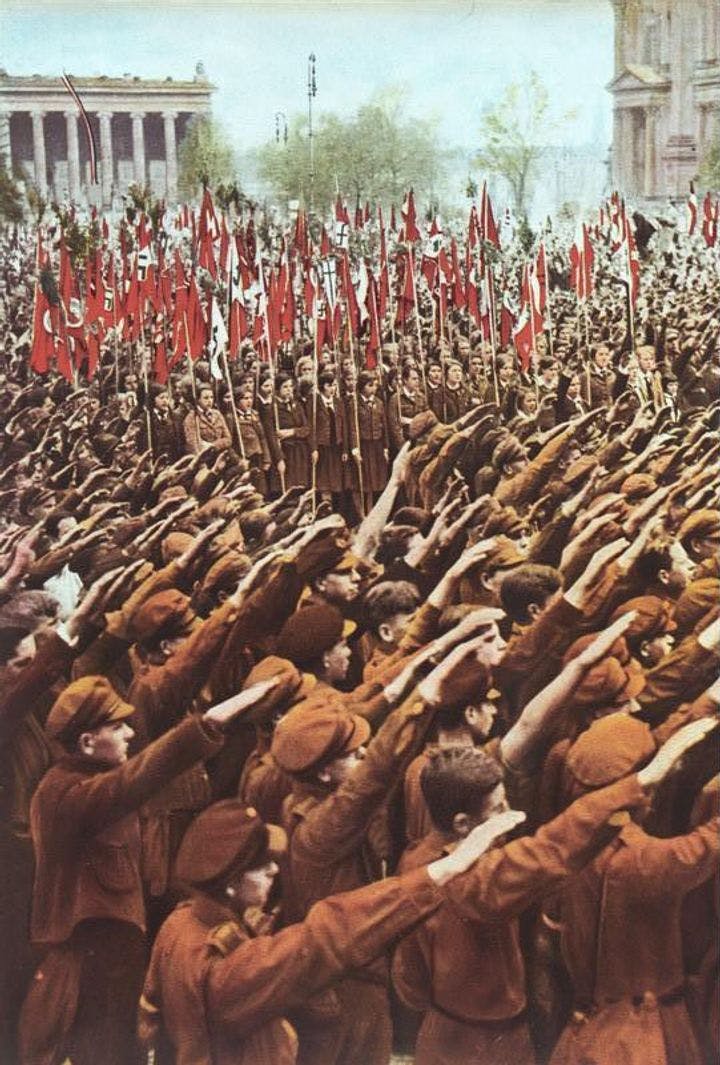Summer 2008
Meet and Greet
– Karl E. Scheibe
Karl E. Scheibe looks at the social meaning behind the Nazi salute.
On this side of the Atlantic, boys mocked the Hitler salute during World War II. I recall holding a pocket comb under my nose with my left hand while extending my right arm, clicking my heels, and intoning, “Heil Hitler!” I never closed the gap of consciousness between my own German heritage and my pleasure in ridiculing my father’s native land. To this day, one may mock and scorn the Nazis without fear of offending anyone’s sensibilities. Mel Brooks’s uproarious comedy The Producers milked this standard Nazi greeting to great effect. How is it that the defining pole of manifest evil in our times is at once chilling and funny?
In The Hitler Salute, German sociologist Tilman Allert has given us an analysis of the famous greeting that is both thorough and modest, accessible and profound. In the scope of 100 pages, he provides a history and interpretation of a most remarkable and telling feature of the totalitarian regime that was National Socialism. By decree from the very beginning of the Nazi era in 1933, this salutation, involving voice and gesture, was prescribed. It was “a historically unique phenomenon that, for the span of 12 years, politicized all communication within German society.”
It is astonishing to observe that the entire German nation quickly abandoned the greeting rituals and habits established over centuries (grüß Gott, auf Wiedersehen, guten Tag, servus) in favor of a salute that was a test and a manifestation of loyalty, a pledge of allegiance to a charismatic leader, and a confession of pious faith in the new order. Of course, there were protests and exceptions. Jews were neither expected nor allowed to use the greeting. Allert notes that the military was slow to substitute the new greeting for its traditional salutes. The Catholic Church did not fall into line immediately. And within families, especially those of the aristocratic classes, traditional greetings survived. But by the end of the war, in 1945, the salute had been assimilated into the routines of everyday life. Then, with Germany’s defeat and the death of Hitler, the custom was abandoned virtually overnight—except by certain prisoners of war and a few fringe political groups.
This work constitutes a brilliant example of what Erving Goffman referred to as the microanalysis of the interaction order. The theoretical structure of the book is drawn from classical sociology—in particular the thought of Max Weber. Greetings are the means by which individuals enter into social arrangements and relationships; the ways greetings are given, received, and reciprocated provide a means of reading status, power, group identity, and disposition toward cooperation or hostility. What sets the Hitler salute apart is that it did not grow out of popular custom, but was imposed from the top down. The comparison that most readily comes to mind is from Aldous Huxley’s 1932 novel Brave New World, in which the citizens of his futuristic society are expected to employ the sign of the T as a gesture of solidarity.
No longer could an individual take public exception to the course of events or seek pleasure in the company of others who might share one’s passions. The only permissible pleasures were collective, communal. “Ultimately,” Allert asserts, “what made it possible for Germans to accept the Hitler greeting was neglect, an attitude in turn made possible by a perception of society that so attenuated people’s expectations of social exchange they became indifferent to the presence of others.” Ordinary Germans, under the watch of suspicious Nazi authorities, abandoned previous social values and lost their trust in social interactions. The path to the extermination camps was paved by such neglect and indifference.
The elimination of individuality betokened by the universal Hitler salute was a form of madness. The relief from this madness was a return to normality—including the capacity to laugh at what was once so tragic.
* * *
Karl E. Scheibe, an emeritus professor of psychology and director of the Wasch Center for Retired Faculty at Wesleyan University, is the author of The Drama of Everyday Life (2000), among other books.
Reviewed: "The Hitler Salute: On the Meaning of a Gesture" by Tilman Allert, translated by Jefferson Chase, Metropolitan Books, 2008.
Photo courtesy of Wikimedia Commons
Up next in this issue
